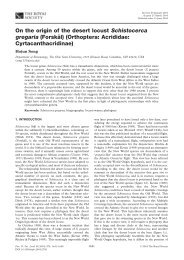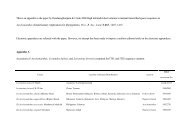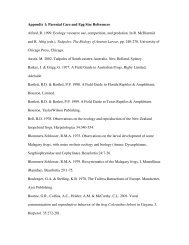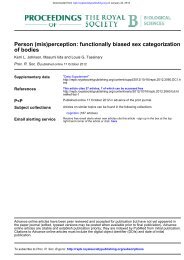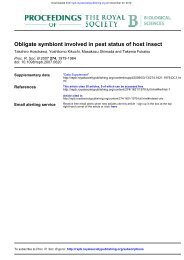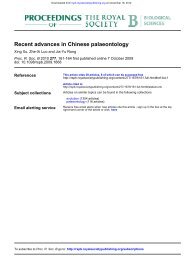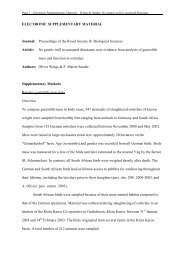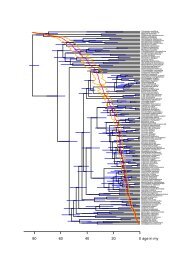rspb20081226_new_ESM.pdf - Proceedings of the Royal Society B
rspb20081226_new_ESM.pdf - Proceedings of the Royal Society B
rspb20081226_new_ESM.pdf - Proceedings of the Royal Society B
Create successful ePaper yourself
Turn your PDF publications into a flip-book with our unique Google optimized e-Paper software.
MATERIALS AND METHODS<br />
(a) Selective exclusion experiments<br />
Electronic Supplementary Material<br />
Fifty Phyllanthus lepidocarpus plants were collected from a wild population in Kyoto<br />
and transplanted individually to 500-ml pots. The plants were kept in a greenhouse for 1<br />
week, and 15–39 female flowers that opened during this period were marked for each<br />
plant. We <strong>the</strong>n applied one <strong>of</strong> <strong>the</strong> following four treatments: (i) <strong>the</strong> plants were bagged<br />
with fine netting to exclude all flower visitors (N = 15), (ii) bagged as above, but ants<br />
were allowed to freely forage through a slit (width, 5 mm) at <strong>the</strong> bottom <strong>of</strong> <strong>the</strong> bagging<br />
(N = 15), (iii) bagged and self-pollinated by hand (N = 5), or (iv) left unbagged as<br />
controls (N = 15). The experimental pots were placed in <strong>the</strong> Kyoto University campus,<br />
where ants were abundant, for 1 week, and <strong>the</strong> proportion <strong>of</strong> marked flowers that<br />
developed into fruits was calculated for each plant. During <strong>the</strong> experiment, we<br />
monitored <strong>the</strong> “ants-only” plants at various times <strong>of</strong> <strong>the</strong> day, between 800 and 2200 h,<br />
for a total <strong>of</strong> 12 h and confirmed that no insects o<strong>the</strong>r than <strong>the</strong> ant Aphaenogaster<br />
famelica were present on <strong>the</strong> plants.<br />
(b) Taxon sampling for <strong>the</strong> Epicephala phylogenetic analysis<br />
The genus Epicephala currently consists <strong>of</strong> > 40 described species with little known<br />
larval biology (de Prins & de Prins 2005) and most likely includes a large number <strong>of</strong><br />
undescribed species as sampled in this study. However, many <strong>of</strong> <strong>the</strong> described species<br />
are known only from <strong>the</strong> type collections and lack sufficient descriptions <strong>of</strong> genitalia<br />
and wing venation, which provide explicit features for <strong>the</strong> grouping <strong>of</strong> genera in<br />
Gracillariidae (Vári 1961). Because we did not include any described species <strong>of</strong><br />
Epicephala or thoroughly sample species from related genera, we were unable to test<br />
<strong>the</strong> monophyly <strong>of</strong> <strong>the</strong> genus or explicitly investigate <strong>the</strong> origin <strong>of</strong> seed feeding within<br />
<strong>the</strong> family. Never<strong>the</strong>less, our extensive sampling <strong>of</strong> Epicephala moths from a broad<br />
range <strong>of</strong> Phyllan<strong>the</strong>ae hosts (table 1) provides a sound basis for investigating overall<br />
evolutionary pattern <strong>of</strong> pollinating behavior and host associations in <strong>the</strong> genus, and<br />
estimating <strong>the</strong>ir divergence times. Sampling <strong>of</strong> Cuphodes diospyrosella and Stomphastis<br />
labyrinthica is based on distinct morphological apomorphies in male and female
genitalia that <strong>the</strong>y share with species <strong>of</strong> Epicephala (A. K., unpublished data).<br />
Melanocercops ficuvorella was sampled as <strong>the</strong> far<strong>the</strong>st outgroup to allow estimation <strong>of</strong><br />
branch length leading to <strong>the</strong> ingroup, which is required in <strong>the</strong> analyses <strong>of</strong> ancestral<br />
character states and divergence times.<br />
(c) Cophylogenetic analysis<br />
To test whe<strong>the</strong>r <strong>the</strong> plant and moth phylogenies are associated at random at higher<br />
taxonomic levels, we performed <strong>the</strong> ParaFit (Legendre et al. 2002) analysis based on<br />
patristic distances calculated along <strong>the</strong> ML phylogeny using PATRISTIC 1.0 (Fourment<br />
& Gibbs 2006). Because <strong>the</strong> phylogenetic results for Epicephala indicated that major<br />
moth clades have specific associations with particular host taxonomic groups, we<br />
reduced <strong>the</strong> following six clades to single terminal taxa: Malagasy Phyllanthus clade,<br />
Glochidion clade, Phyllanthus section Gomphidium clade, Breynia clade, Phyllanthus<br />
subgenus Kirganelia clade, and Phyllanthus section Adenoglochidion clade (see fig. S2<br />
for clade names). Pruning was done by averaging patristic distances across all<br />
constituent species in each clade. Similarly, we extracted <strong>the</strong> species hosting Epicephala<br />
from <strong>the</strong> plant phylogeny and constructed a patristic distance matrix by reducing <strong>the</strong><br />
above-mentioned taxonomic groups to single taxa.<br />
(d) Phyllanthaceae fossils<br />
A list <strong>of</strong> known Phyllanthaceae fossils is given in table S7. Of <strong>the</strong>se, we selected <strong>the</strong><br />
following four non-redundant fossils as minimum age constraints in <strong>the</strong> divergence time<br />
estimation <strong>of</strong> <strong>the</strong> Phyllanthaceae phylogeny: Bisch<strong>of</strong>ia-type pollen from Bartonian,<br />
Middle Eocene (37.2 mya); Actephila-type pollen from Late Eocene (33.9 mya);<br />
Phyllanthus-type pollen from Early Eocene (48.6 mya) (Gruas-Cavagnetto & Köhler<br />
1992); and Glochidion leaf impressions from Middle Miocene (11.6 mya) (Prasad 1994;<br />
Antal & Prasad 1996). Ages <strong>of</strong> <strong>the</strong> fossils are given as <strong>the</strong> upper boundaries <strong>of</strong><br />
epochs/stages to which <strong>the</strong>y belong (geologic times based on Gradstein et al. 2004). The<br />
Actephila-type pollen had palynological features most closely related to Actephila but<br />
also showed some affinity to genera such as Andrachne, Leptopus, and Meinekia<br />
(Gruas-Cavagnetto & Köhler 1992), all <strong>of</strong> which are members <strong>of</strong> Poran<strong>the</strong>reae; thus, we<br />
used this fossil to provide minimum age for <strong>the</strong> Poran<strong>the</strong>reae–Wielandieae split (fig.<br />
S3). We did not use <strong>the</strong> Reverchonia-type pollen to constrain <strong>the</strong> age <strong>of</strong> Reverchonia,
ecause this fossil pollen does not precisely match those <strong>of</strong> <strong>the</strong> modern species (<strong>the</strong><br />
monotypic Reverchonia arenaria; Sagun & van der Ham 2003) and exhibits some<br />
features associated with members <strong>of</strong> Phyllanthus (Gruas-Cavagnetto & Köhler 1992).<br />
Thus, we regard this fossil as Phyllanthus to be conservative, which consequently<br />
becomes redundant to <strong>the</strong> older Phyllanthus-type pollen. We also did not use <strong>the</strong><br />
Bridelia wood fossil, because <strong>the</strong> assignment <strong>of</strong> Phyllanthaceae wood fossils to modern<br />
taxa is not straightforward (Prakash et al. 1986) and <strong>the</strong> age <strong>of</strong> <strong>the</strong> present fossil is too<br />
young to provide a meaningful lower bound on node ages. Because precise attribution<br />
<strong>of</strong> some <strong>of</strong> <strong>the</strong> Phyllanthaceae fossils may still require refinements (Gruas-Cavagnetto<br />
& Köhler 1992), <strong>the</strong> estimated divergence times may be revised when fossils with a<br />
more reliable taxonomic placement become available. Never<strong>the</strong>less, taxa belonging to<br />
Phyllan<strong>the</strong>ae are well represented in <strong>the</strong> fossil record during <strong>the</strong> Eocene–Miocene times<br />
(table S7), providing evidence for <strong>the</strong> antiquity <strong>of</strong> <strong>the</strong> tribe as a whole.<br />
(e) Priors for Bayesian divergence time estimation<br />
The following prior distributions on parameters were used for <strong>the</strong> Bayesian divergence<br />
time estimation in Phyllanthaceae. The prior mean ± SD for <strong>the</strong> age at root node was set<br />
to ei<strong>the</strong>r 125 ± 20 myr (based on <strong>the</strong> earliest occurrence <strong>of</strong> eudicot pollen; Magallón et<br />
al. 1999) or 108 ± 20 myr (based on <strong>the</strong> estimated maximum age <strong>of</strong> <strong>the</strong> corresponding<br />
node in Davis et al. 2003). These values were divided by 100 so that <strong>the</strong>y fall between<br />
0.1 and 10, which is <strong>the</strong> recommended range <strong>of</strong> prior mean for <strong>the</strong> root age. The<br />
corresponding prior distributions <strong>of</strong> rate at root node were 0.88 ± 0.44 and 0.1 ± 0.05,<br />
which were obtained by dividing <strong>the</strong> median <strong>of</strong> <strong>the</strong> distances between <strong>the</strong> ingroup root<br />
and <strong>the</strong> tips by <strong>the</strong> respective prior root age (standard deviations were set to half <strong>the</strong><br />
values <strong>of</strong> <strong>the</strong> means). The prior for <strong>the</strong> Brownian motion parameter was 1.0 ± 1.0 for<br />
both analyses, which fall between 1 and 2 when multiplied by <strong>the</strong> prior root age, as<br />
recommended by <strong>the</strong> program manual.<br />
The prior distributions on parameters for <strong>the</strong> Epicephala divergence time estimation<br />
were as follows. The root node age was set to 1.0 ± 0.0, which is equivalent to fixing<br />
<strong>the</strong> root age with one unit time, <strong>the</strong> rate at ingroup root was 0.12 ± 0.06, based on<br />
median distance between <strong>the</strong> ingroup root and <strong>the</strong> tips, and <strong>the</strong> Brownian motion<br />
parameter was 1.0 ±1.0, as recommended by <strong>the</strong> manual.
RESULTS<br />
(a) Associations with Epicephala in Phyllan<strong>the</strong>ae<br />
The examination <strong>of</strong> flowers and fruits in Phyllan<strong>the</strong>ae showed that 18 <strong>of</strong> <strong>the</strong> 26 species<br />
studied did not have associations with Epicephala moths (table S1), indicating that <strong>the</strong>y<br />
are not involved in pollination <strong>of</strong> <strong>the</strong>se species. In turn, Epicephala moths parasitized<br />
fruits in eight <strong>of</strong> <strong>the</strong> 26 species studied. Of <strong>the</strong>se, four species (P. reticulatus, P. sp., P.<br />
marojejiensis, and P. humbertii) belonging to two major Phyllanthus taxonomic groups<br />
(section Anisonema and unclassified Malagasy clade) were <strong>new</strong>ly found to have <strong>the</strong><br />
Epicephala pollination system on <strong>the</strong> grounds that <strong>the</strong>re was a significant association<br />
between pollinated status and <strong>the</strong> presence <strong>of</strong> Epicephala eggs in female flowers (table<br />
S2), <strong>the</strong> styles were simple and not spread (fig. 2 in <strong>the</strong> printed paper), and/or female<br />
moths were observed pollinating flowers. Epicephala moths associated with P.<br />
reticulatus were observed pollinating female flowers in a manner typical <strong>of</strong> o<strong>the</strong>r<br />
actively pollinating species. We also collected a single female on a P. marojejiensis<br />
plant that bore > 100 pollen grains on her proboscis, suggesting that this species is also<br />
a pollinator.<br />
The remaining four species that had associations with Epicephala (F. suffruticosa, P.<br />
ussuriensis, P. lepidocarpus, and P. amarus) were visited by abundant diurnal insects<br />
(table S3). Flueggea suffruticosa attracted a wide variety <strong>of</strong> insects that foraged for<br />
nectar and pollen, which are likely pollinators <strong>of</strong> this plant. The o<strong>the</strong>r three species,<br />
which are all herbaceous, were visited predominantly by ants, and pollination<br />
experiments in P. lepidocarpus indicated that ants are effective pollinators (table S8).<br />
Observation <strong>of</strong> Epicephala moth behaviour suggested that <strong>the</strong> moths do not pollinate<br />
<strong>the</strong>se flowers. In F. suffruticosa, female moths laid eggs in flower buds, flowers, or<br />
developing fruits and did not carry pollen grains on <strong>the</strong> proboscis (N = 32). In P.<br />
lepidocarpus and P. amarus, Epicephala females laid eggs only in young fruits and<br />
carried no pollen grains (N = 15 and 9, respectively). The absence <strong>of</strong> Epicephala moths<br />
in some <strong>of</strong> <strong>the</strong> studied populations <strong>of</strong> <strong>the</strong>se plants fur<strong>the</strong>r indicates that <strong>the</strong>y are not<br />
dependent on Epicephala for pollination. Based on <strong>the</strong>se observations, we conclude that<br />
Epicephala moths associated with <strong>the</strong> above four species are truly parasitic,<br />
non-pollinating seed parasites.
(b) Divergence time estimation in Epicephala<br />
Calibration <strong>of</strong> <strong>the</strong> Epicephala tree based on <strong>the</strong> COI molecular clock (1.5% myr -1 )<br />
suggested that <strong>the</strong> crown group Epicephala most likely diverged 20–35 mya (fig. 4 in<br />
<strong>the</strong> printed paper). The estimated constant rate <strong>of</strong> COI sequence divergence in<br />
arthropods ranges between 1.3% and 2.3% myr -1 (Brower 1994; Quek et al. 2004).<br />
However, <strong>the</strong> use <strong>of</strong> higher rates would only result in younger estimates for <strong>the</strong><br />
Epicephala root node; thus, our method is conservative with respect to providing young<br />
ages. The outlying old age estimates (fig. 4) were contributed by <strong>the</strong> shallowest nodes<br />
on <strong>the</strong> Epicephala chronogram, which are most prone to stochastic error in divergence<br />
time estimations (Ho et al. 2005; Sota & Hayashi 2007). On <strong>the</strong> o<strong>the</strong>r hand, ages<br />
provided by deeper nodes clustered within a narrow time frame between 20 and 30 mya<br />
(fig. 4). When <strong>the</strong> moth tree is calibrated with 25 mya at <strong>the</strong> Epicephala crown group<br />
(fig. 3), roughly concordant ages were obtained for <strong>the</strong> associated plant and moth clades,<br />
indicating <strong>the</strong> robustness <strong>of</strong> our age estimates (e.g., Phyllanthus section Gomphidium<br />
and <strong>the</strong>ir pollinators, 7.75–15.16 and 7.36–10.47 mya, respectively; section<br />
Adenoglochidion and pollinators, 2.56–7.98 and 5.38–9.24 mya, respectively; Breynia<br />
and pollinators, 5.01–13.26 and 3.32–5.34 mya, respectively; Glochidion and<br />
pollinators, 1.46–4.69 mya and 5.26–8.08 mya, respectively).<br />
REFERENCES<br />
Agarwal, A. 2002 Contributions to <strong>the</strong> fossil leaf assemblage from Miocene, Neyveli<br />
lignite deposits, Tamil Nadu, India. Palaeontogr. Abt. B261, 167–206.<br />
Agarwal, A. & Mandaokar, B. 2002 A leaf impression from early Miocene <strong>of</strong> Mizoram,<br />
India. Phytomorphology 52, 311–314.<br />
Antal, J. S. & Prasad, M. 1996 Some more leaf-impressions from <strong>the</strong> Himalayan<br />
foot-hills <strong>of</strong> Darjeeling District, West Bengal, India. Palaeobotanist 43, 1–9.<br />
Davis, C. C., Webb, C. O., Wurdack, K. J., Jaramillo, C. A. & Donoghue, M. J. 2005<br />
Explosive radiation <strong>of</strong> Malpighiales supports a mid-Cretaceous origin <strong>of</strong> modern<br />
tropical rain forests. Am. Nat. 165, E36–E65.<br />
De Prins, W. & de Prins, J. 2005 World Catalogue <strong>of</strong> Insects, Vol. 6, Gracillariidae<br />
(Lepidoptera). Stenstrup, Denmark: Apollo Books.<br />
Dor<strong>of</strong>eev, P. I. 1958 Novye dannye ob oligocenovoj flore u. d. Rezenki v Zapadnoj<br />
Sibiri. Dokl. Akad. nauk SSSR 123, 171–174.
Dor<strong>of</strong>eev, P. I. 1959 Ob oligocenovoj flore s. Kozjulino v ust’e r. Tomi. Dokl. Akad.<br />
nauk SSSR 127, 1103–1105.<br />
Dor<strong>of</strong>eev, P. I. 1960 Novye danne o treticnych florach Kireevskovo Jara na r. Obi. Dokl.<br />
Akad. nauk SSSR 133, 211–213.<br />
Fourment, M. & Gibbs, M. 2006 PATRISTIC: a program for calculating patristic<br />
distances and graphically comparing <strong>the</strong> components <strong>of</strong> genetic change. BMC Evol.<br />
Biol. 6, 1.<br />
Gradstein, F. M., Ogg, J. G. & Smith, A. G. 2004 A Geologic Time Scale 2004.<br />
Cambridge, MA: Cambridge University Press.<br />
Gruas-Cavagnetto, C. & Köhler, E. 1992 Pollens fossiles d’Euphorbiacées de l’Eocène<br />
français. Grana 31, 291–304.<br />
Ho, S. Y. W., Phillips, M. J., Cooper, A. & Drummond, A. J. 2005 Time dependency <strong>of</strong><br />
molecular rate estimates and systematic overestimation <strong>of</strong> recent divergence times.<br />
Mol. Biol. Evol. 22, 1561–1568.<br />
Lancucka-Srodoniowa, M. 1966 Tortonian flora from <strong>the</strong> “Gdow-Bay” in <strong>the</strong> South <strong>of</strong><br />
Poland. Acta Palaeobot. 7, 3–135.<br />
Legendre, P., Desdevises, Y. & Bazin, E. 2002 A statistical test for host–parasite<br />
coevolution. Syst. Biol. 51, 217–234.<br />
Li, C. Y., Wang, C. M., Hsiao, J. Y. & Yang, C. H. 2003 Two fossil dicotyledonous<br />
woods from <strong>the</strong> Kungkuan Tuff (Early Miocene), nor<strong>the</strong>rn Taiwan. Col. Res. 16,<br />
71–78.<br />
Magallón, S., Crane, P. R. & Herendeen, P. S. 1999. Phylogenetic pattern, diversity,<br />
and diversification <strong>of</strong> eudicots. Ann. MO Bot. Gard. 86, 297–372.<br />
Mai, D. H. 1996 Zwei neue Arten von Samen aus dem deutschen Jungtertiär. Feddes<br />
Repert. 107, 299–393.<br />
Prakash, U., Bande, M. B. & Lalitha, V. 1986 The genus Phyllanthus from Tertiary <strong>of</strong><br />
India with critical remarks on <strong>the</strong> nomenclature <strong>of</strong> fossil woods <strong>of</strong> Euphorbiaceae.<br />
Palaeobotanist 35, 106–114.<br />
Prasad, M. 1994 Siwalik (Middle Miocene) leaf impressions from <strong>the</strong> foothills <strong>of</strong> <strong>the</strong><br />
Himalayas, India. Tertiary Res. 15, 53–90.<br />
Prasad, M. & Awasthi, N. 1996 Contributions to <strong>the</strong> Siwalik flora from Surai khola<br />
sequence, western Nepal and its palaeoecological and phytogeographical<br />
implications. Palaeobotanist 43, 1–42.
Prasad, M., Antal, J. S., Tripathi, P. P. & Pandey, V. K. 1999 Fur<strong>the</strong>r contribution <strong>of</strong> <strong>the</strong><br />
Siwalik flora from <strong>the</strong> Koilabas area, western Nepal. Palaeobotanist 48, 49–95.<br />
Quek, S. P., Davies, S. J., Itino, T. & Pierce, N. E. 2004 Codiversification in an<br />
ant–plant mutualism: stem texture and <strong>the</strong> evolution <strong>of</strong> host use in Crematogaster<br />
(Formicidae: Myrmicinae) inhabitants <strong>of</strong> Macaranga (Euphorbiaceae). Evolution 58,<br />
554–570.<br />
Sagun, V. G. & van der Ham, R. W. J. M. 2003 Pollen morphology <strong>of</strong> <strong>the</strong> Flueggeinae<br />
(Euphorbiaceae, Phyllanthoideae). Grana 42, 193–219.<br />
Sota, T. & Hayashi, M. 2007 Comparative historical biogeography <strong>of</strong> Plateumaris leaf<br />
beetles (Coleoptera: Chrysomelidae) in Japan: interplay between fossil and<br />
molecular data. J. Biogeogr. 34, 977–993.<br />
Vári, L. 1961 South African Lepidoptera, Vol. I, Lithocolletidae. Transv. Mus. Mem. 12,<br />
1–238.<br />
Yang, J. J., Qi, G. F., Xu, R. H. &Yang L. M. 1998 Studies on three fossil woods <strong>of</strong><br />
Euphorbiaceae excavated from Wuhan area. Acta Bot. Sin. 40, 68–76.<br />
Zaklinskaja, E. D. 1978 Palynology <strong>of</strong> Paleogene clay from DSDP Site 368, Cape<br />
Verde Rise. Init. Rep. Deep Sea Drill. Proj. 41, 933–937.
Figure legends<br />
Figure S1. Bayesian majority consensus cladogram <strong>of</strong> Phyllanthaceae based on<br />
4,059-bp aligned sequences <strong>of</strong> combined plastid matK, ndhF, atpB, and nuclear PHYC<br />
genes. Numbers indicate maximum parsimony and likelihood bootstrap values, and<br />
Bayesian posterior probability (from top to bottom; shown only when > 50). Asterisks<br />
indicate maximal nodal support (100 for all three measures).<br />
Figure S2. Bayesian majority consensus cladogram <strong>of</strong> Epicephala based on 2,933-bp<br />
aligned sequences <strong>of</strong> combined mitochondrial COI and nuclear ArgK, EF-1α, Wg, and<br />
18S rDNA genes. Numbers indicate parsimony and likelihood bootstrap values, and<br />
Bayesian posterior probability (from top to bottom; shown only when > 50). Asterisks<br />
indicate maximal nodal support (100 for all three measures). Epicephala species are<br />
currently all undescribed; thus, host associations are given as taxon labels. Associated<br />
host taxonomic groups are also given.<br />
Figure S3. Penalized likelihood chronogram <strong>of</strong> Phyllanthaceae based on 4,059-bp<br />
aligned sequences <strong>of</strong> combined plastid matK, ndhF, atpB, and nuclear PHYC genes.<br />
Maximum age constraint (a) and minimum age fossil constraints (b–e) are indicated.<br />
95% confidence intervals are shown with shaded bars.<br />
Figure S4. Penalized likelihood chronogram <strong>of</strong> Epicephala based on 2,933-bp aligned<br />
sequences <strong>of</strong> combined mitochondrial COI and nuclear ArgK, EF-1α, Wg, and 18S<br />
rDNA genes. Branches are scaled to one arbitrary time unit fixed at <strong>the</strong> root node. 95%<br />
confidence intervals are shown with shaded bars.
Table S1. Presence/absence <strong>of</strong> Epicephala larvae in fruits and eggs in flowers<br />
Fruits Flowers<br />
No. <strong>of</strong> fruits Ovules per Fruits No. <strong>of</strong> flowers No. <strong>of</strong> flowers Pollinated<br />
Species Locality (plants) fruit †<br />
infested (%) (plants) pollinated with eggs (%)<br />
Margaritaria<br />
M. discoidea Bossou 28 (1) 6 0 n. a. n. a. n. a.<br />
Flueggea<br />
F. suffruticosa Hyogo 461 (4) 6 51 379 (2) 379 13.2<br />
Hiroshima n. a. n. a. n. a. 393 (8) 365 6.3<br />
Amami Is. 115 (2) 6 0 n. a. n. a. n. a.<br />
F. virosa Vieng Xai 243 (3) 6 0 n. a. n. a. n. a.<br />
Phyllanthus<br />
P. (Is.) ussuriensis Tokyo 29 (12) 6 44.8 n. a. n. a. n. a.<br />
Kyoto 148 (6) 6 0 275 (6) 217 0<br />
P. (Is.) virgatus Vientiane 233 (31) 6 0 n. a. n. a. n. a.<br />
P. (Er.) liukiuensis Okinawa Is. 139 (16) 6 0 82 (11) 53 0<br />
P. (Er.) pulcheroides Mahaxai 53 (6) 6 0 38 (4) 17 0<br />
P. (Ki.) flexuosus Kyoto 193 (4) 6 0 81 (4) 72 0<br />
Hyogo 51 (1) 6 0 n. a. n. a. n. a.<br />
Miyazaki 79 (2) 6 0 n. a. n. a. n. a.<br />
P. (Ki.) oligospermus Yonaguni Is. 123 (5) 6 0 182 (3) 167 0<br />
P. (Ki.) reticulatus Henchun 61 (3) 16.4 (12–20) 78.7 251 (3) 120 89.2<br />
P. (Ki.) sp. Lakxao n. a. n. a. n. a. 170 (2) 54 94.4<br />
P. (Ki.) tenellus Okinawa Is. 322 (7) 6 0 190 (10) 169 0<br />
P. (Ph.) lepidocarpus Kyoto 100 (5) 6 0 106 (5) 104 0<br />
Miyako Is. 184 (10) 6 17.4 129 (10) 114 0<br />
Ishigaki Is. 207 (10) 6 49.8 176 (10) 162 0<br />
P. (Ph.) amarus Ishigaki Is. 212 (6) 6 0 171 (6) 148 0<br />
P. (Ph.) debilis Ishigaki Is. 76 (7) 6 0 68 (7) 62 0<br />
P. (Ci.) acidus Vientiane 200 (2) 6 0 n. a. n. a. n. a.<br />
P. (Em.) emblica Ban Chomesy 111 (2) 6 0 n. a. n. a. n. a.<br />
P. (Pd.) roseus Phialat 53 (3) 6 0 158 (3) 120 0<br />
P. marojejiensis Mt. Marojeji 49 (6) 6.2 (6–8) 77.8 116 (11) 59 56<br />
P. humbertii Mt. Marojeji 27 (5) 6 88.9 n. a. n. a. n. a.<br />
Reverchonia<br />
R. arenaria New Mexico 266 (18) 6 0 n. a. n. a. n. a.<br />
Breynia<br />
B. retusa Vientiane 138 (4) 6 0 226 (4) 112 0<br />
Sauropus<br />
S. quadrangularis Vientiane 43 (11) 6 0 128 (13) 73 0<br />
S. brevipes Vientiane 19 (8) 6 0 88 (11) 37 0<br />
S. androgynus Thakhaek 78 (6) 6 0 70 (6) 34 0<br />
S. granulosus Vientiane n. a. n. a. n. a. 25 (5) 15 0<br />
† Mean and range in paren<strong>the</strong>ses for species with variable ovule number.
Table S2. Associations between pollination and presence/absence <strong>of</strong> Epicephala eggs in<br />
female flowers.<br />
Species<br />
Locality (No. <strong>of</strong> plants) No eggs With eggs Significance †<br />
Flueggea suffuruticosa<br />
Hyogo (2) Pollinated 329 50 P = 1<br />
Un-pollinated 0 0<br />
Hiroshima (8) Pollinated 342 23 P = 0.1735<br />
Un-pollinated 28 0<br />
Phyllanthus reticulatus<br />
Henchun (3) Pollinated 13 107 P < 0.0001<br />
Un-pollinated 131 0<br />
Phyllanthus sp.<br />
Laksao (2) Pollinated 3 51 P < 0.0001<br />
Un-pollinated 116 0<br />
Phyllanthus marojejiensis<br />
Mt. Marojeji (11) Pollinated 3 56 P < 0.0001<br />
Un-pollinated 57 0<br />
† Significance <strong>of</strong> association between pollination and egg presence assessed by Fisher's exact test.
Table S3. Flower visitors <strong>of</strong> Phyllan<strong>the</strong>ae plants<br />
Genus Hours observed Pollen<br />
Species Study site Day Night Insect species Family: order † Visitation rate § attachment ‡<br />
Flueggea<br />
F. suffruticosa Hyogo 0.2 11.0 Adoretus tenuimaculatus Sca: Col 5.0 ++<br />
Eucetonia roel<strong>of</strong>si Sca: Col 5.0 +++<br />
Betasyrphus serarius Syr: Dip 5.0 +++<br />
Phytomya zonata Syr: Dip 5.0 +++<br />
Sphaerophoria philanthus Syr: Dip 25.0 +++<br />
Odontomyia garatas Str: Dip 5.0 +++<br />
Stomorhina obsoleta Cal: Dip 130.0 +++<br />
Phasia crassipennis Pha: Dip 5.0 +++<br />
Lasioglossum sp. 1 Hal: Hym 10.0 +++<br />
Lasioglossum sp. 2 Hal: Hym 45.0 +++<br />
Lasioglossum sp. 3 Hal: Hym 70.0 +++<br />
Apis cerana Api: Hym 65.0 +++<br />
Epicephala sp. 1 Gra: Lep 3.5<br />
F. suffruticosa Amami Is. 0.3 Stomorhina obsoleta Cal: Dip 50.0 +++<br />
Ophyra sp. Ant: Dip 3.3 +<br />
Homoneura sp. Lau: Dip 3.3 +++<br />
Polistes jokahamae Ves: Hym 6.7 +++<br />
Lasioglossum sp. 4 Hal: Hym 16.7 +++<br />
F. virosa Fangliao 0.3 Eristalinus quinquestriatus Syr: Dip 6.7 +++<br />
Ischiodon scutellaris Syr: Dip 6.7 ++<br />
Paragus sp. Syr: Dip 10.0 ++<br />
Stomorhina obsoleta Cal: Dip 50.0 +++<br />
Chrysomya sp. 1 Cal: Dip 3.3 +++<br />
Chrysomya sp. 2 Cal: Dip 10.0 +++<br />
Polleniopsis sp. Cal: Dip 6.7 +++<br />
Parasarcophaga sp. Sar: Dip 10.0 +++<br />
Siphona sp. Tac: Dip 20.0 +++<br />
Braunsapis sp. Api: Hym 3.3 +++<br />
Apis cerana Api: Hym 20.0 +++<br />
Apis mellifera Api: Hym 16.7 +++<br />
Amata sp. Arc: Lep 3.3 +++<br />
Princeps demoleus Pap: Lep 3.3 +++<br />
Eurema hecabe Pie: Lep 3.3 +<br />
Precis lemonias Nym: Lep 3.3 +<br />
Precis iphita Nym: Lep 3.3 +++
Hypolimnas misippus Nym: Lep 3.3 +<br />
Phyllanthus<br />
P. (Is.) ussuriensis Kyoto 1.0 Tetramorium sp. 1 For: Hym 5.0 +<br />
Tetramorium sp. 2 For: Hym 2.0<br />
P. (Is.) virgatus Vientiane 0.3 Paragus sp. Syr: Dip 6.7 ++<br />
Camponotus sp. For: Hym 13.3 +<br />
Solenopsis sp. For: Hym 10.0 +<br />
P. (Ki.) flexuosus Kyoto 8.0 Pidonia puziloi Cer: Col 0.5 +++<br />
Pidonia simillima Cer: Col 0.3 +++<br />
Ezonacerda sp. Oed: Col 0.1 +++<br />
sp. Cec: Dip 2.4 ++<br />
Rhamphomyia formidabilis Emp: Dip 0.3 ++<br />
Episyrphus balteatus Syr: Dip 0.1 +++<br />
Sphegina sp. Syr: Dip 0.1 +++<br />
Graptomyza itoi Syr: Dip 0.1 ++<br />
Phorticella sp. Dro: Dip 0.1 ++<br />
Spilichneumon nonagriae Ich: Hym 0.1 +<br />
P. (Ki.) oligospermus Yonaguni Is. 3.0 Episyrphus sp. Syr: Dip 0.7 ++<br />
Chrysomya sp. 3 Cal: Dip 0.3 +++<br />
Rhinia zanthogaster Cal: Dip 0.3 +<br />
Lasioglossum sp. 5 Hal: Hym 0.3 +++<br />
P. (Ki.) reticulatus Henchun 5.0 7.0 Epicephala sp. 2 Gra: Lep 2.9 +++<br />
P. (Ki.) tenellus Okinawa Is. 0.5 —<br />
P. (Ph.) lepidocarpus Kyoto 0.5 Formica japonica For: Hym 22.0 +++<br />
Formica sp. For: Hym 24.0 ++<br />
Miyako Is. 0.3 2.0 Tetramorium sp. 3 For: Hym 24.0 ++<br />
Anoplolepis gracilipes For: Hym 3.3 +<br />
Epicephala sp. 3 (on young fruit) Gra: Lep 6.5<br />
Ishigaki Is. 0.3 Technomyrmex sp. For: Hym 10.0 ++<br />
Tapinoma sp. For: Hym 10.0 ++<br />
Tetramorium sp. 4 For: Hym 26.7 ++<br />
P. (Ph.) amarus Ishigaki Is. 0.3 Monomorium sp. 1 For: Hym 20.0 ++<br />
Thakhaek 1.5 Epicephala sp. 4 (on young fruit) Gra: Lep 4.0<br />
P. (Ph.) debilis Ishigaki Is. 0.3 Monomorium sp. 2 For: Hym 16.7 ++<br />
P. (Ph.) liukiuensis Okinawa Is. 3.0 Mallochohelea sp. Crt: Dip 0.7 +<br />
P. (Pd.) roseus Phialat 2.0 sp. Cur: Col 0.5 ++<br />
Stomorhina obsoleta Cal: Dip 2.5 +++<br />
sp. Lau: Dip 0.5 ++<br />
P. marojejiensis Mt. Marojeji 4.0 4.0 Epicephala sp. 5 (on leaf) Gra: Lep 0.3 +++
Reverchonia<br />
R. arenaria New Mexico 3.0 sp. Bru: Col 0.3<br />
Sphixapata trilineata Sar: Dip 1.0 +<br />
Lasioglossum sp. 6 Hal: Hym 0.3 +<br />
Breynia<br />
B. retusa Vientiane 2.0 Clinodiplosis sp. Cec: Dip 4.5 ++<br />
Sauropus<br />
S. quadrangularis Vientiane 8.0 Paragus sp. Syr: Dip 0.5 +++<br />
S. brevipes Vientiane 4.0 —<br />
S. androgynus Thakhaek 1.0 —<br />
S. granulosus Vientiane 2.0 Halictus sp. Hal: Hym 0.5 +++<br />
† Abbreviations for family and order names: Ant, Anthomyiidae; Api, Apidae; Arc, Arctiidae; Bru, Bruchidae; Cal, Calliphoridae; Cec, Cecidomyiidae; Cer,<br />
Cerambycidae; Crt, Ceratopogonidae; Coc, Coccinellidae; Cur, Curculionidae; Dro, Drosophilidae; Emp, Empididae; For, Formicidae; Gra, Gracillariidae; Hal,<br />
Halictidae; Ich, Ichneumonidae; Lau, Lauxaniidae; Mus, Muscidae; Nit, Nitidulidae; Nym, Nymphalidae; Oed, Oedemeridae; Pap, Papilionidae; Pha, Phasiidae;<br />
Pie, Pieridae; Pla, Plataspidae; Sar, Sarcophagidae; Sca, Scarabaeidae; Str, Stratiomyidae; Syr, Syrphidae; Ves, Vespidae; Col, Coleoptera; Dip, Diptera; Hem,<br />
Hemiptera; Hym, Hymenoptera; Lep, Lepidoptera.<br />
§ Visitation rate is given as <strong>the</strong> number <strong>of</strong> individuals collected per plant per hour for each insect species.<br />
‡ Amount <strong>of</strong> pollen load is assessed as: +,
Table S4. List <strong>of</strong> matK primers<br />
Primer name † Strand Sequence (5′ to 3′)<br />
phy-matk1 F CTTHTNTTTCGGGARTATATT<br />
phy-matk6 F TAAARCGTTTAATTACTCG<br />
phy-matk3 § F GRTTYTTTCTTCACGAGTATTG<br />
phy-matk4 § R CGAGRGAYTGYTTCGATAATG<br />
phy-matk2 R ACAAAYAATATCMAAATACC<br />
† Primers are located in this order from <strong>the</strong> 5′-end to <strong>the</strong> 3′-end.<br />
§ Used for sequencing only.
Table S5. GenBank accession numbers for <strong>the</strong> plant sequences used in this study.<br />
matK ndhF atpB PHYC<br />
Ingroup<br />
Margaritaria discoidea FJ235280 FJ235490 FJ235326 FJ235372<br />
Margaritaria indica FJ235279 FJ235489 FJ235325 FJ235371<br />
Flueggea jullienii FJ235278 FJ235488 FJ235324 FJ235370<br />
Flueggea suffruticosa FJ235276 FJ235486 FJ235322 FJ235368<br />
Flueggea virosa FJ235277 FJ235487 FJ235323 FJ235369<br />
Phyllanthus ussuriensis FJ235274 FJ235484 FJ235320 FJ235366<br />
Phyllanthus virgatus FJ235275 FJ235485 FJ235321 FJ235367<br />
Phyllanthus liukiuensis FJ235272 FJ235482 FJ235318 FJ235364<br />
Phyllanthus pulcheroides FJ235273 FJ235483 FJ235319 FJ235365<br />
Phyllanthus reticulatus FJ235270 FJ235480 FJ235316 FJ235362<br />
Phyllanthus sp. FJ235271 FJ235481 FJ235317 FJ235363<br />
Phyllanthus flexuosus FJ235269 FJ235479 FJ235315 FJ235361<br />
Phyllanthus oligospermus FJ235268 FJ235478 FJ235314 FJ235360<br />
Phyllanthus tenellus FJ235267 FJ235477 FJ235313 FJ235359<br />
Phyllanthus amarus FJ235264 FJ235474 FJ235310 FJ235356<br />
Phyllanthus debilis FJ235265 FJ235475 FJ235311 FJ235357<br />
Phyllanthus lepidocarpus FJ235252 FJ235462 FJ235298 FJ235344<br />
Phyllanthus aeneus FJ235260 FJ235470 FJ235306 FJ235352<br />
Phyllanthus gneissicus FJ235262 FJ235472 FJ235308 FJ235354<br />
Phyllanthus guillauminii FJ235263 FJ235473 FJ235309 FJ235355<br />
Phyllanthus vulcani FJ235261 FJ235471 FJ235307 FJ235353<br />
Phyllanthus bourgeoisii FJ235256 FJ235466 FJ235302 FJ235348<br />
Phyllanthus chamaecerasus FJ235255 FJ235465 FJ235301 FJ235347<br />
Phyllanthus caudatus FJ235259 FJ235469 FJ235305 FJ235351<br />
Phyllanthus koniamboensis FJ235258 FJ235468 FJ235304 FJ235350<br />
Phyllanthus mangenotii FJ235257 FJ235467 FJ235303 FJ235349<br />
Phyllanthus acidus FJ235250 FJ235460 FJ235296 FJ235342<br />
Phyllanthus emblica FJ235251 FJ235461 FJ235297 FJ235343<br />
Phyllanthus roseus FJ235240 FJ235450 FJ235286 FJ235332<br />
Phyllanthus marojejiensis FJ235254 FJ235464 FJ235300 FJ235346<br />
Phyllanthus humbertii FJ235253 FJ235463 FJ235299 FJ235345<br />
Reverchonia arenaria FJ235266 FJ235476 FJ235312 FJ235358<br />
Sauropus androgynus FJ235247 FJ235457 FJ235293 FJ235339<br />
Sauropus brevipes FJ235248 FJ235458 FJ235294 FJ235340<br />
Sauropus granulosus FJ235246 FJ235456 FJ235292 FJ235338<br />
Sauropus quadrangularis FJ235249 FJ235459 FJ235295 FJ235341<br />
Breynia disticha FJ235241 FJ235451 FJ235287 FJ235333<br />
Breynia fruticosa FJ235245 FJ235455 FJ235291 FJ235337<br />
Breynia oblongifolia FJ235242 FJ235452 FJ235288 FJ235334<br />
Breynia retusa FJ235244 FJ235454 FJ235290 FJ235336<br />
Breynia vitis-idaea FJ235243 FJ235453 FJ235289 FJ235335<br />
Glochidion acuminatum FJ235239 FJ235449 FJ235285 FJ235331<br />
Glochidion lanceolatum FJ235235 FJ235445 FJ235281 FJ235327<br />
Glochidion obovatum FJ235238 FJ235448 FJ235284 FJ235330<br />
Glochidion rubrum FJ235236 FJ235446 FJ235282 FJ235328<br />
Glochidion zeylanicum FJ235237 FJ235447 FJ235283 FJ235329<br />
Outgroup (Phyllanthaceae)<br />
Actephila lindleyi AY552415 AY830190 AY579830<br />
Amanoa strobilacea AY830258 AY830289 AY830191 AY830365<br />
Andrachne aspera AY830259 AY830290 AY830192 AY830366
Andrachne ovalis AY830260 AY830291 AY830193 AY830367<br />
Antidesma alexiteria AY552416 AY830292 AY830194 AY579832<br />
Apodiscus chevalieri AY552418 AY830294 AY830195 AY579834<br />
Aporosa frutescens AY552417 AY830295 AY830196 AY579835<br />
Astrocasia neurocarpa AY830261 AY830296 AY830197 AY830368<br />
Baccaurea javanica AY579878 AY830297 AY830198 AY579836<br />
Baccaurea lanceolata AY552419 AY830298 AY830199 AY579837<br />
Bisch<strong>of</strong>ia javanica AY552420 AY830299 AY830200 AY579838<br />
Blotia leandriana AY552440 AY830300 AY830201 AY579862<br />
Bridelia ferruginea AY830262 AY830303 AY830204 AY830370<br />
Bridelia insulana AY830263 AY830304 AY830295<br />
Bridelia retusa AY552421 AY830305 AY830206 AY579841<br />
Cleistanthus oblongifolius AY552424 AY830307 AY579843<br />
Cleistanthus perrieri AY552425 AY830308 AY830207 AY579842<br />
Cleistanthus suarezensis AY830265 AY830309 AY830208<br />
Croizatia brevipetiolata AY830310 AY788213 AY830371<br />
Discocarpus essequaboensis AY830267 AY830312 AY830209<br />
Gonatogyne brasiliensis AY552429 AY830316 AY830213 AY579850<br />
Heywoodia lucens AY552430 AY830317 AY830214 AY579851<br />
Hieronyma oblonga AY830268 AY830318 AY830215<br />
Hymenocardia acida AY830269 AY830319 AY830216 AY830373<br />
Lachnostylis bilocularis AY552431 AY830321 AY830218 AY579854<br />
Leptopus colchicus AY552434 AY830322 AY830220 AY579856<br />
Leptopus cordifolius AY552433 AY830323 AY830219 AY579855<br />
Leptopus diplospermus AY830271 AY830325 AY830221<br />
Maesobotrya vermeulenii AY830273 AY830327 AY830224<br />
Martretia quadricornis AY830275 AY830331 AY830228 AY830377<br />
Meineckia phyllanthoides AY552436 AY830332 AY830229 AY579857<br />
Petalodiscus bojerianus AY552439 AY830351 AY830247 AY579860<br />
Petalodiscus fadenii AY552437 AY830334 AY830231 AY579859<br />
Petalodiscus platyrachis AY552441 AY830335 AY830232 AY579861<br />
Poran<strong>the</strong>ra corymbosa AY552447 AY830239 AY579870<br />
Poran<strong>the</strong>ra microphylla AY830342 AY830240 AY830379<br />
Pseudolachnostylis maprouneifolia AY552448 AY830344 AY830241 AY579871<br />
Savia dictyocarpa AY552449 AY830352 AY830248 AY579873<br />
Securinega durissima AY830285 AY830353 AY830249 AY830382<br />
Spondianthus preussii AY830286 AY830354 AY830250 AY830383<br />
Thecacoris madagascariensis AY552452 AY830355 AY830251 AY579874<br />
Uapaca guineensis AY830287 AY830356 AY830390 AY830385<br />
Uapaca littoralis AY830288 AY830357 AY830252 AY830384<br />
Wielandia elegans AY552454 AY830358 AY830253 AY579875<br />
Zimmermannia capillipes AY552455 AY830359 AY830254 AY579876<br />
Zimmermanniopsis uzungwaensis AY552456 AY830360 AY830255 AY579877<br />
Outgroup (Picrodendraceae)<br />
Androstachys johnsonii AY552461 AY830361 AF209527 AY579831<br />
Hyaenanche globosa AY552462 AY830363 AY579852<br />
Outgroup (Putranjivaceae)<br />
Drypetes madagascariensis AY552458 AY830362 AY830256 AY579845<br />
Putranjiva zeylanica AY552459 AY830364 AY830257 AY830386
Table S6. GenBank accession numbers for <strong>the</strong> moth sequences used in this study.<br />
COI ArgK EF-1a Wg 18S rDNA<br />
Ingroup (Epicephala)<br />
E. sp. ex Flueggea suffruticosa FJ235373 FJ235392 FJ235491 FJ235206 FJ235416<br />
E. sp. ex Phyllanthus ussuriensis FJ235387 FJ235411 FJ235510 FJ235225 FJ235435<br />
E. sp. ex Phyllanthus reticulatus FJ235383 FJ235407 FJ235506 FJ235221 FJ235431<br />
E. sp. ex Phyllanthus sp. FJ235382 FJ235406 FJ235505 FJ235220 FJ235430<br />
E. sp. ex Phyllanthus amarus FJ235388 FJ235412 FJ235511 FJ235226 FJ235436<br />
E. sp. ex Phyllanthus lepidocarpus FJ235386 FJ235410 FJ235509 FJ235224 FJ235434<br />
E. sp. ex Phyllanthus aeneus AY269393 FJ235401 FJ235500 FJ235215 FJ235425<br />
E. sp. ex Phyllanthus gneissicus FJ235376 FJ235398 FJ235497 FJ235212 FJ235422<br />
E. sp. ex Phyllanthus guillauminii AY269399 FJ235399 FJ235498 FJ235213 FJ235423<br />
E. sp. ex Phyllanthus vulcani FJ235377 FJ235400 FJ235499 FJ235214 FJ235424<br />
E. sp. ex Phyllanthus bourgeoisii AY269404 FJ235395 FJ235494 FJ235209 FJ235419<br />
E. sp. ex Phyllanthus chamaecerasus AY269411 FJ235397 FJ235496 FJ235211 FJ235421<br />
E. sp. ex Phyllanthus caudatus FJ235375 FJ235396 FJ235495 FJ235210 FJ235420<br />
E. sp. ex Phyllanthus koniamboensis FJ235374 FJ235394 FJ235493 FJ235208 FJ235418<br />
E. sp. ex Phyllanthus mangenotii AY269397 FJ235393 FJ235492 FJ235207 FJ235417<br />
E. sp. ex Phyllanthus marojejiensis FJ235378 FJ235402 FJ235501 FJ235216 FJ235426<br />
E. sp. ex Phyllanthus humbertii FJ235379 FJ235403 FJ235502 FJ235217 FJ235427<br />
E. sp. ex Breynia disticha FJ235381 FJ235405 FJ235504 FJ235219 FJ235429<br />
E. sp. ex Breynia fruticosa FJ235380 FJ235404 FJ235503 FJ235218 FJ235428<br />
E. sp. ex Breynia oblongifolia FJ235384 FJ235408 FJ235507 FJ235222 FJ235432<br />
E. sp. ex Breynia vitis-idaea FJ235385 FJ235409 FJ235508 FJ235223 FJ235433<br />
E. sp. ex Glochidion acuminatum DQ298955 DQ298844 DQ299051 FJ235229 FJ235439<br />
E. sp. ex Glochidion lanceolatum DQ298967 DQ298858 DQ299065 FJ235227 FJ235437<br />
E. sp. ex Glochidion obovatum DQ299009 DQ298903 DQ299110 FJ235230 FJ235440<br />
E. sp. ex Glochidion rubrum DQ299027 DQ298924 DQ299131 FJ235228 FJ235438<br />
E. sp. ex Glochidion zeylanicum DQ299039 DQ298937 DQ299144 FJ235231 FJ235441<br />
Outgroup<br />
Cuphodes diospyrosella FJ235389 FJ235413 FJ235512 FJ235232 FJ235442<br />
Stomphastis labyrinthica FJ235390 FJ235414 FJ235513 FJ235233 FJ235443<br />
Melanocercops ficuvorella FJ235391 FJ235415 FJ235514 FJ235234 FJ235444
Table S7. Phyllanthaceae fossil records. Fossils indicated in bold were used to constrain node ages in <strong>the</strong> dating analysis.<br />
Extant taxon Fossil taxon Fossil type Epoch, stage Age (mya) † Location Reference<br />
Glochidion Glochidion miocenica Leaf Middle Miocene 11.6 Kathgodam, Uttar Pradesh,<br />
India<br />
Prasad (1994)<br />
Glochidion Glochidion palaeohirsutum Leaf Middle Miocene 11.6 Darjeeling, West Bengal,<br />
India<br />
Antal and Prasad (1996)<br />
Phyllanthus Phyllanthus wuhanensis Wood Pliocene 1.8 Wuhan, Hubei, China Yang et al. (1998)<br />
Phyllanthus Phyllanthus palaeoreticulatus Leaf Miocene 5.3 Suraikhola, Nepal Prasad and Awasthi (1996)<br />
Phyllanthus Phyllanthus palaeoreticulatus Leaf Miocene 5.3 Tamil Nadu, India Agarwal (2002)<br />
Phyllanthus Phyllanthus securinegiformis Seed Miocene 5.3 Lower Lusatia, Germany Mai (1996)<br />
Phyllanthus Phyllanthus sexseminata Seed Late Miocene,<br />
Tortonian<br />
7.2 Gdow Bay, Poland Lancucka-Srodoniowa (1966)<br />
Phyllanthus Phyllanthus mioreticulatus Leaf Middle Miocene 11.6 Koilabas, Nepal Prasad et al. (1999)<br />
Phyllanthus Phyllanthus koilabesensis Leaf Middle Miocene 11.6 Koilabas, Nepal Prasad et al. (1999)<br />
Phyllanthus Phyllanthus siwalica Leaf Middle Miocene 11.6 Kathgodam, Uttar Pradesh,<br />
India<br />
Prasad (1994)<br />
Phyllanthus Phyllanthus type Leaf Early Miocene 16.0 Mampui, Mizoram, India Agarwal and Mandaokar (2002)<br />
Phyllanthus Phyllanthus kireevskiana Seed Oligocene 23.0 Kireevsk, Russia Dor<strong>of</strong>eev (1960)<br />
Phyllanthus Phyllanthus triquetra Seed Oligocene 23.0 Kozyulino, Tomsk, Russia Dor<strong>of</strong>eev (1959)<br />
Phyllanthus Phyllanthus compassica Seed Late Oligocene,<br />
Chattian<br />
23.0 Rezhenka, Tomsk, Russia Dor<strong>of</strong>eev (1958)<br />
Phyllanthus Phyllanthus type Pollen Late Eocene 33.9 Cape Verde Rise, Atlantic<br />
Ocean<br />
Zaklinskaja (1978)<br />
Phyllanthus Reverchonia type Pollen Late Eocene 33.9 Mont Pagnotte, Oise, Gruas-Cavagnetto and Köhler<br />
France<br />
(1992)<br />
Phyllanthus Phyllanthus type Pollen Early Eocene 48.6 New Haven, East Sussex, Gruas-Cavagnetto and Köhler<br />
UK<br />
(1992)<br />
Poran<strong>the</strong>reae Actephila type Pollen Late Eocene 33.9 Celas, Gard, France Gruas-Cavagnetto and Köhler<br />
(1992)<br />
Bridelia Bridelia wuhanensis Wood Pliocene 1.8 Wuhan, Hubei, China Yang et al. (1998)<br />
Bisch<strong>of</strong>ia Bisch<strong>of</strong>ia polycarpa Wood Pliocene 1.8 Wuhan, Hubei, China Yang et al. (1998)<br />
Bisch<strong>of</strong>ia Bisch<strong>of</strong>ia javanoxyla Wood Early Miocene 16.0 Kweishan, Taoyuan, Taiwan Li et al. (2003)<br />
Bisch<strong>of</strong>ia Bisch<strong>of</strong>ia type Pollen Middle Eocene, 37.2 Manche, France Gruas-Cavagnetto and Köhler<br />
Bartonian<br />
(1992)<br />
†<br />
Oldest reliable age <strong>of</strong> <strong>the</strong> fossil given as <strong>the</strong> upper boundary <strong>of</strong> each epoch/stage (geologic times based on Gradstein et al., 2004).
Table S8. Results <strong>of</strong> selective exclusion experiments in Phyllanthus<br />
lepidocarpus<br />
Plants Flowers per plant Fruit set †<br />
Control 15 20–32 99.4 a<br />
Bagged with fine mesh 15 26–38 0.0 b<br />
Only ants allowed to forage 15 22–39 99.1 a<br />
Hand self-pollinated 5 15 100.0 a<br />
† Fruit sets in <strong>the</strong> four treatments were significantly different (Kruskal-Wallis test,<br />
χ 2 = 40.01, df = 3, P < 0.001). Letters with different superscript letters indicate<br />
significant difference.
Phyllanthaceae<br />
96<br />
89<br />
100<br />
Phyllan<strong>the</strong>ae<br />
*<br />
-<br />
66<br />
75<br />
*<br />
97<br />
91<br />
100<br />
100<br />
98<br />
100<br />
* *<br />
*<br />
52<br />
96<br />
100<br />
*<br />
*<br />
*<br />
*<br />
87<br />
92<br />
100<br />
*<br />
*<br />
*<br />
*<br />
*<br />
*<br />
96<br />
94<br />
100<br />
*<br />
80<br />
83<br />
100<br />
-<br />
-<br />
80<br />
100<br />
99<br />
100<br />
*<br />
96<br />
97<br />
100<br />
98<br />
99<br />
100<br />
*<br />
*<br />
*<br />
-<br />
57<br />
69<br />
67<br />
70<br />
69<br />
*<br />
100<br />
99<br />
100<br />
*<br />
-<br />
-<br />
99<br />
*<br />
*<br />
*<br />
-<br />
- -<br />
72 57<br />
63<br />
*<br />
*<br />
-<br />
-<br />
64<br />
66<br />
-<br />
66<br />
-<br />
-<br />
80<br />
95<br />
95<br />
100<br />
77<br />
- 82<br />
- 100<br />
100 93<br />
99<br />
100<br />
56<br />
58<br />
80 62<br />
67<br />
100<br />
*<br />
*<br />
*<br />
*<br />
*<br />
63<br />
68<br />
98<br />
61<br />
76<br />
100<br />
62<br />
56<br />
97<br />
*<br />
*<br />
*<br />
* *<br />
*<br />
86<br />
92<br />
100<br />
*<br />
95<br />
80<br />
100<br />
89<br />
88<br />
100<br />
76<br />
91<br />
100<br />
69<br />
80<br />
99<br />
*<br />
98<br />
56<br />
100<br />
75<br />
68<br />
64 *<br />
96<br />
94<br />
100 98<br />
97<br />
100<br />
90<br />
85<br />
87<br />
*<br />
*<br />
63<br />
-<br />
56<br />
*<br />
*<br />
*<br />
Breynia retusa<br />
Breynia fruticosa<br />
Breynia vitis-idaea<br />
Breynia disticha<br />
Breynia oblongifolia<br />
Sauropus granulosus<br />
Sauropus brevipes<br />
Sauropus quadrangularis<br />
Sauropus androgynus<br />
Glochidion lanceolatum<br />
Glochidion zeylanicum<br />
Glochidion acuminatum<br />
Glochidion obovatum<br />
Glochidion rubrum<br />
Phyllanthus (Pd.) roseus<br />
Phyllanthus (Em.) emblica<br />
Phyllanthus (Ph.) lepidocarpus<br />
Phyllanthus humbertii<br />
Phyllanthus marojejiensis<br />
Phyllanthus (Ci.) acidus<br />
Phyllanthus (Go.) chamaecerasus<br />
Phyllanthus (Go.) caudatus<br />
Phyllanthus (Go.) bourgeoisii<br />
Phyllanthus (Go.) koniamboensis<br />
Phyllanthus (Go.) mangenotii<br />
Phyllanthus (Go.) aeneus<br />
Phyllanthus (Go.) guillauminii<br />
Phyllanthus (Go.) vulcani<br />
Phyllanthus (Go.) gneissicus<br />
Phyllanthus (Ph.) amarus<br />
Reverchonia arenaria<br />
Phyllanthus (Ph.) debilis<br />
Phyllanthus (Ki.) tenellus<br />
Phyllanthus (Ki.) oligospermus<br />
Phyllanthus (Ki.) flexuosus<br />
Phyllanthus (Ki.) reticulatus<br />
Phyllanthus (Ki.) sp.<br />
Phyllanthus (Er.) liukiuensis<br />
Phyllanthus (Er.) pulcheroides<br />
Phyllanthus (Is.) ussuriensis<br />
Phyllanthus (Is.) virgatus<br />
Breynia<br />
Sauropus<br />
Glochidion<br />
Flueggea suffruticosa<br />
Flueggea virosa<br />
Flueggea jullienii<br />
Margaritaria indica<br />
Margaritaria discoidea<br />
Leptopus colchicus<br />
Leptopus cordifolius<br />
Actephila lindleyi<br />
Poran<strong>the</strong>ra corymbosa<br />
Poran<strong>the</strong>ra microphylla<br />
Andrachne ovalis<br />
Zimmermannia capillipes<br />
Zimmermanniopsis uzungwaensis<br />
Meineckia phyllanthoides<br />
Andrachne aspera<br />
Blotia leandriana<br />
Petalodiscus fadenii<br />
Wielandia elegans<br />
Petalodiscus platyrachis<br />
Petalodiscus bojerianus<br />
Chorisandrachne diplosperma<br />
Astrocasia neurocarpa<br />
Heywoodia lucens<br />
Bridelia insulana<br />
Bridelia retusa<br />
Bridelia ferruginea<br />
Cleistanthus oblongifolius<br />
Pseudolachnostylis maprouneifolia<br />
Cleistanthus perrieri<br />
Cleistanthus suarezensis<br />
Amanoa strobilacea<br />
Croizatia brevipetiolata<br />
Discocarpus essequeboensis<br />
Gonatogyne brasiliensis<br />
Savia dictyocarpa<br />
Lachnostylis bilocularis<br />
Securinega durissima<br />
Antidesma alexiteria<br />
Thecacoris madagascariensis<br />
Apodiscus chevalieri<br />
Martretia quadricornis<br />
Hieronyma oblonga<br />
Hymenocardia acida<br />
Spondianthus preussii<br />
Uapaca guineensis<br />
Uapaca littoralis<br />
Baccaurea javanica<br />
Baccaurea lanceolata<br />
Aporosa frutescens<br />
Maesobotrya vermeulenii<br />
Bisch<strong>of</strong>ia javanica<br />
Androstachys johnsonii<br />
Hyaenanche globosa<br />
Drypetes madagascariensis<br />
Putranjiva zeylanica<br />
Reverchonia<br />
Flueggea<br />
Margaritaria<br />
Phyllanthus<br />
Poran<strong>the</strong>reae<br />
Wielandieae<br />
Bridelieae<br />
Antidesmateae<br />
Spondian<strong>the</strong>ae<br />
Uapaceae<br />
Scepeae<br />
Bisch<strong>of</strong>ieae<br />
Picrodendraceae<br />
Putranjivaceae
Epicephala<br />
97<br />
100<br />
100<br />
88<br />
97<br />
100<br />
99<br />
100<br />
100<br />
88<br />
84<br />
68<br />
*<br />
99<br />
100<br />
100<br />
77<br />
61<br />
99<br />
99<br />
100<br />
100<br />
86<br />
97<br />
100<br />
92<br />
79<br />
100<br />
62<br />
60<br />
76<br />
*<br />
*<br />
99<br />
100<br />
100<br />
92<br />
100<br />
100<br />
-<br />
-<br />
64<br />
*<br />
67<br />
59<br />
64<br />
61<br />
72<br />
88<br />
*<br />
-<br />
58<br />
74<br />
73<br />
88<br />
100<br />
-<br />
61<br />
80<br />
94<br />
99<br />
100<br />
*<br />
E. sp. ex P. ussuriensis<br />
E. sp. ex P. amarus<br />
E. sp. ex P. lepidocarpus<br />
E. sp. ex P. marojejiensis<br />
E. sp. ex P. humbertii<br />
E. sp. ex G. acuminatum<br />
E. sp. ex G. obovatum<br />
E. sp. ex G. rubrum<br />
E. sp. ex G. lanceolatum<br />
E. sp. ex G. zeylanicum<br />
E. sp. ex P. gneissicus<br />
E. sp. ex P. vulcani<br />
E. sp. ex P. guillauminii<br />
E. sp. ex P. aeneus<br />
E. sp. ex B. disticha<br />
E. sp. ex B. oblongifolia<br />
E. sp. ex B. vitis-idaea<br />
E. sp. ex B. fruticosa<br />
E. sp. ex P. sp.<br />
E. sp. ex P. reticulatus<br />
E. sp. ex P. mangenotii<br />
E. sp. ex P. chamaecerasus<br />
E. sp. ex P. koniamboensis<br />
E. sp. ex P. caudatus<br />
E. sp. ex P. bourgeoisii<br />
E. sp. ex F. suffruticosa<br />
Cuphodes diospyrosella<br />
Stomphastis labyrinthica<br />
Melanocercops ficuvorella<br />
Herbaceous Phyllanthus<br />
(unrelated)<br />
Malagasy Phyllanthus<br />
Glochidion<br />
Phyllanthus subgenus<br />
Gomphidium<br />
section Gomphidium<br />
Breynia<br />
Phyllanthus subgenus<br />
Kirganelia<br />
Phyllanthus subgenus<br />
Gomphidium<br />
section Adenoglochidion<br />
Flueggea
a<br />
c<br />
b<br />
Most recent common<br />
ancestor <strong>of</strong> Epicephalapollinated<br />
species<br />
Phyllan<strong>the</strong>ae<br />
d<br />
100 50 0 (mya)<br />
e<br />
B. retusa<br />
B. fruticosa<br />
B. vitis-idaea<br />
B. disticha<br />
B. oblongifolia<br />
S. granulosus<br />
S. brevipes<br />
S. quadrangularis<br />
S. androgynus<br />
G. lanceolatum<br />
G. zeylanicum<br />
G. acuminatum<br />
G. obovatum<br />
G. rubrum<br />
P. (Pd.) roseus<br />
P. (Em.) emblica<br />
P. (Ph.) lepidocarpus<br />
P. humbertii<br />
P. marojejiensis<br />
P. (Ci.) acidus<br />
P. (Go.) chamaecerasus<br />
P. (Go.) caudatus<br />
P. (Go.) bourgeoisii<br />
P. (Go.) koniamboensis<br />
P. (Go.) mangenotii<br />
P. (Go.) aeneus<br />
P. (Go.) guillauminii<br />
P. (Go.) vulcani<br />
P. (Go.) gneissicus<br />
P. (Ph.) amarus<br />
R. arenaria<br />
P. (Ph.) debilis<br />
P. (Ki.) tenellus<br />
P. (Ki.) oligospermus<br />
P. (Ki.) flexuosus<br />
P. (Ki.) reticulatus<br />
P. (Ki.) sp.<br />
P. (Er.) liukiuensis<br />
P. (Er.) pulcheroides<br />
P. (Is.) ussuriensis<br />
P. (Is.) virgatus<br />
F. suffruticosa<br />
F. virosa<br />
F. jullienii<br />
M. indica<br />
M. discoidea<br />
L. colchicus<br />
L. cordifolius<br />
A. lindleyi<br />
P. corymbosa<br />
P. microphylla<br />
A. ovalis<br />
Z. capillipes<br />
Z. uzungwaensis<br />
M. phyllanthoides<br />
A. aspera<br />
B. leandriana<br />
P. fadenii<br />
W. elegans<br />
P. bojerianus<br />
P. platyrachis<br />
C. diplospermus<br />
A. neurocarpa<br />
H. lucens<br />
B. ferruginea<br />
B. retusa<br />
B. insulana<br />
C. oblongifolius<br />
P. maprouneifolia<br />
C. perrieri<br />
C. suarezensis<br />
A. strobilacea<br />
C. brevipetiolata<br />
D. essequeboensis<br />
G. brasiliensis<br />
S. dictyocarpa<br />
L. bilocularis<br />
S. durissima<br />
A. alexiteria<br />
T. madagascariensis<br />
H. acida<br />
A. chevalieri<br />
M. quadricornis<br />
H. oblonga<br />
S. preussii<br />
U. guineensis<br />
U. littoralis<br />
B. javanica<br />
B. lanceolata<br />
A. frutescens<br />
M. vermeulenii<br />
B. javanica<br />
A. johnsonii<br />
H. globosa
1 0.5 0<br />
Arbitrary time unit<br />
E. sp. ex P. ussuriensis<br />
E. sp. ex P. amarus<br />
E. sp. ex P. lepidocarpus<br />
E. sp. ex P. marojejiensis<br />
E. sp. ex P. humbertii<br />
E. sp. ex G. acuminatum<br />
E. sp. ex G. obovatum<br />
E. sp. ex G. rubrum<br />
E. sp. ex G. lanceolatum<br />
E. sp. ex G. zeylanicum<br />
E. sp. ex P. gneissicus<br />
E. sp. ex P. vulcani<br />
E. sp. ex P. guillauminii<br />
E. sp. ex P. aeneus<br />
E. sp. ex B. disticha<br />
E. sp. ex B. oblongifolia<br />
E. sp. ex B. vitis-idaea<br />
E. sp. ex B. fruticosa<br />
E. sp. ex P. sp.<br />
E. sp. ex P. reticulatus<br />
E. sp. ex P. mangenotii<br />
E. sp. ex P. chamaecerasus<br />
E. sp. ex P. koniamboensis<br />
E. sp. ex P. caudatus<br />
E. sp. ex P. bourgeoisii<br />
E. sp. ex F. suffruticosa



